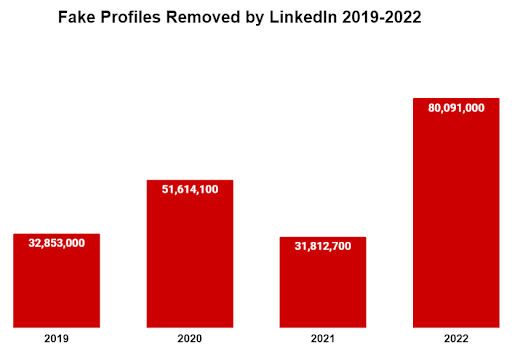BLOG
Articles about website spoofing, cybersecurity trends, and how to protect your customers from hackers.
LinkedIn Fakes: The Rise of Spoof Profiles Threatening Brand Reputation
Last year set a new record for fake profiles removed from the LinkedIn platform. This shows that fraudsters are dedicating more time and effort to scams that involve some use of LinkedIn. Fake LinkedIn account volume more than doubled, increasing 152% over 2021 to more than 80 million fake profiles removed in 2022.
Allure Security’s in-house team of takedown experts handles LinkedIn takedowns every day. With this article we will explain recent scams proliferating on LinkedIn and how they harm your brand’s reputation online. An upcoming blog post will dive deeper into responding to brand impersonations on LinkedIn with information about how to go about reporting and taking down fake accounts impersonating your brand or employees.

Brand Costs of Fake LinkedIn Profiles
Not only do victims lose up to millions-of-dollars each to investment scams distributed over LinkedIn for example, but rampant brand impersonation also damages businesses and their reputations. As the FBI explained in a warning issued in February 2022, impersonated brands risk the following:
- Unaware they’ve been scammed, victims of fake job postings may write negative reviews of the impersonated company, affecting ratings on company review sites
- Similarly, victims may sully a company’s name on social media platforms.
- Job candidates may avoid companies associated with fake job scams and apply with competitors.
- Administrative time and cost associated with following-up with victims that applied for fake jobs.
The resulting brand and reputational damage from such scams makes hiring more difficult and jeopardizes customer, partner, and investor trust. Time is of the essence in protecting your brand on LinkedIn. You want to find fake profiles impersonating your brand or employees as close to when they’re originally published as you can, and get them taken down as quickly as possible. Every minute a fake profile impersonating your brand remains online increases the number of people victimized and damage done to your brand.
Recent Scams on LinkedIn
A variety of different types of scams take place on LinkedIn including:
- Advance-fee scams
- Job scams
- Investment scams
- Dating/romance scams
The majority of businesses come to Allure Security for help with fake profiles impersonating their company or employees (current or former) and facilitating fake job or investment scams. A number of state attorneys general have also recently issued warnings about “pig butchering” which can begin with a LinkedIn message from what turns out to be a fake profile.
Fake Job or Employment Scams
Some businesses come to us for help with fake job postings impersonating their company on LinkedIn and devaluing their employer brand. The rise in remote work during the pandemic contributed to an increase in these scams whose objective is stealing personal or payment information or to engage in advance-fee fraud.
At a high level, here’s how these scams work:
- Scammers create profiles impersonating legitimate companies or employees
- They post fake job ads on LinkedIn or other job sites or reach out directly to LinkedIn members with direct messages
- Victims apply, sometimes paying application fees or having to divulge personally identifiable information or banking details
- Victims undergo fake interviews, usually via teleconference
- They are then “hired” and asked to pay onboarding fees for equipment, etc. or asked to provide banking details to facilitate direct deposit
- The scammer profits by “collecting” any application or onboarding fees, draining bank accounts or selling the victim’s data
Investment Scams
Some of our financial services customers originally came to us concerned about investment scams occurring on social media platforms that impersonated their brand or individual financial advisors at their company. In a typical investment scam, the scammer will create a fake LinkedIn profile impersonating an authentic individual financial advisor at a particular firm.
The “advisor” will reach out to the victim with an investment opportunity, typically involving cryptocurrency. The scammer may originally direct the victim to a legitimate trading platform but eventually direct them to transfer funds to a scam website controlled by the attacker. At that point the money is lost.
Because Linkedin is a professional networking platform, victims sometimes view investment offers made via LinkedIn as more legitimate than an offer over Facebook or Twitter for example.
Pig Butchering
A pig butchering scam – a sort of mix between romance and investment scams – involves longer cons where a scammer nurtures a digital relationship with the victim before persuading them to invest in cryptocurrency.
It gets its name from the concept of fattening up a pig before slaughter. In this case, the “fattening up” is building the victim’s trust in the fraudster. A pig butchering scam can start on any social media platform, LinkedIn being just one example. A particularly distressing aspect of pig butchering scams is that sometimes the fraudsters themselves are victims of human trafficking.
For the most part, while a pig butchering scam can begin on LinkedIn, fraudsters will usually try to move the victim to conversing on another platform such as WhatsApp. To get a better feeling for how such a scam operates from the victim’s point of view, see this analysis.
Tips for Protecting your Brand on LinkedIn
If you have responsibility for protecting your brand online, review the following checklist of actions that will help you protect your brand and reputation on LinkedIn.
- Register your trademarks: A registered, maintained trademark is crucial to persuading any service provider or social media platform to take action on misuse of your brand on their systems. If your brand hasn’t done so already, head to the US Patent and Trademark office website and submit an application to register your brand’s trademarks.
- Establish your brand on LinkedIn: If you don’t already have one, create your LinkedIn Company Page and link to it on your official website. Determine who on staff should serve as the page’s administrators and keep up with a regular posting cadence to reassure users that the page is active and your legitimate company is administrating it.
- Manage your LinkedIn brand page permissions: LinkedIn has two administrator tiers – admin and super admin. Work with your peers on security, marketing, HR, and legal teams to determine which staff members should hold what type of administrator permissions. Also develop and communicate an incident response plan should the company page or any administrator accounts be compromised.
- Verify job listings: With fake job scams increasing on LinkedIn, regularly search for your brand name on LinkedIn and verify that only legitimate job listings are associated with your organization. If you encounter fake listings, report them (more details on this process in an upcoming blog post).
- Verify employees: Similar to tip 4 above, regularly verify LinkedIn members that list your company as their place of employment. Keeping up good hygiene in this area will help ensure only legitimate employees list your brand as their place of work and help cut-down somewhat on fraudsters creating profiles posing as employees in order to carry-out job, investment, and other scams.
- Consider partnering with an online brand protection expert: Your employees likely have better things to do than go on a wild goose chase after impersonations of your brand on LinkedIn, other social media networks and elsewhere on the internet. An online brand protection vendor such as Allure Security can provide more effective, efficient brand protection that also frees up valuable employee time.
WHAT YOU SHOULD DO NEXT
- Contact us if you want to proactively find and take down fake LinkedIn profiles impersonating your brand and employees.
- Take a look at our free Guide to Online Brand Protection to compare your current brand protection efforts with best practices.
- Read our blog post about another rising threat to brands – cloned mobile apps that include malicious code and impersonate trusted brands on mobile beta-testing platforms.
Posted by Sam Bakken

